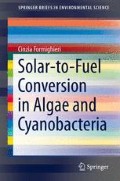Abstract
One way to increase light utilization by the single cell would be to reduce excess absorption of light by identifying bottlenecks in downstream electron transfer and biochemical reactions. The main rate-limiting step at increasing light intensity is carbon dioxide assimilation through the Calvin–Benson cycle. Proper supply of carbon dioxide during growth of algae in photobioreactor, coupled to genetic improvement of carbon dioxide fixation, could improve biomass productivity.
Access this chapter
Tax calculation will be finalised at checkout
Purchases are for personal use only
References
Atsumi S, Higashide W, Liao JC (2009) Direct photosynthetic recycling of carbon dioxide to isobutyraldehyde. Nat Biotechnol 27:1177–1180
Bonente G, Pippa S, Castellano S, Bassi R, Ballottari M (2011) Acclimation of Chlamydomonas reinhardtii to different growth irradiances. J Biol Chem 287:5833–5847
de Morais MG, Costa JAV (2007) Carbon dioxide fixation by Chlorella kessleri, C-vulgaris, Scenedesmus obliquus and Spirulina sp cultivated in flasks and vertical tubular photobioreactors. Biotechnol Lett 29:1349–1352
Eberhard S, Finazzi G, Wollman FA (2008) The dynamics of photosynthesis. Annu Rev Genet 42:463–515
Fang L, Lin HX, Low CS, Wu MH, Chow Y, Lee YK (2012) Expression of the Chlamydomonas reinhardtii Sedoheptulose-1,7-bisphosphatase in Dunaliella bardawil leads to enhanced photosynthesis and increased glycerol production. Plant Biotechnol J 10:1129–1135
Giordano M, Beardall J, Raven JA (2005) CO2 concentrating mechanisms in algae: mechanisms, environmental modulation, and evolution. Annu Rev Plant Biol 56:99–131
Kebeish R, Niessen M, Thiruveedhi K, Bari R, Hirsch HJ, Rosenkranz R, Stäbler N, Schönfeld B, Kreuzaler F, Peterhänsel C (2007) Chloroplastic photorespiratory bypass increases photosynthesis and biomass production in Arabidopsis thaliana. Nat Biotechnol 25:593–599
Keffer JE, Kleinheinz GT (2002) Use of Chlorella vulgaris for CO(2) mitigation in a photobioreactor. J Ind Microbiol Biotechnol 29:275–280
Kliphuis AM, Martens DE, Janssen M, Wijffels RH (2011) Effect of O2:CO2 ratio on the primary metabolism of Chlamydomonas reinhardtii. Biotechnol Bioeng 108:2390–2402
Kramer DM, Avenson TJ, Edwards GE (2004) Dynamic flexibility in the light reactions of photosynthesis governed by both electron and proton transfer reactions. Trends Plant Sci 9:349–357
Lefebvre S, Lawson T, Zakhleniuk OV, Lloyd JC, Raines CA, Fryer M (2005) Increased sedoheptulose-1,7-bisphosphatase activity in transgenic tobacco plants stimulates photosynthesis and growth from an early stage in development. Plant Physiol 138:451–460
Lin MT, Occhialini A, Andralojc PJ, Parry MAJ, Hanson MR (2014) A faster Rubisco with potential to increase photosynthesis in crops. Nature 513:547–550
Liska AJ, Shevchenko A, Pick U, Katz A (2004) Enhanced photosynthesis and redox energy production contribute to salinity tolerance in Dunaliella as revealed by homology-based proteomics. Plant Physiol 136:2806–2817
McNevin D, von Caemmerer S, Graham Farquhar G (2006) Determining RuBisCO activation kinetics and other rate and equilibrium constants by simultaneous multiple non-linear regression of a kinetic model. J Exp Bot 57:3883–3900
Miyagawa Y, Tamoi M, Shigeoka S (2001) Overexpression of a cyanobacterial fructose-1,6/sedoheptulose-1,7-bisphosphatase in tobacco enhances photosynthesis and growth. Nat Biotechnol 19:965–969
Morweiser M, Kruse O, Hankamer B, Posten C (2010) Developments and perspectives of photobioreactors for biofuel production. Appl Microbiol Biotechnol 87:1291–1301
Otsuki T (2001) A study for the biological CO2 fixation and utilization system. Sci Total Environ 277:21–25
Subramanian S, Barry AN, Pieris S (2013) Sayre RT (2013) Comparative energetics and kinetics of autotrophic lipid and starch metabolism in chlorophytic microalgae: implications for biomass and biofuel production. Biotechnol Biofuels 6:150
Zhu XG, Long SP, Ort DR (2010) Improving photosynthetic efficiency for greater yield. Annu Rev Plant Biol 61:235–261
Author information
Authors and Affiliations
Rights and permissions
Copyright information
© 2015 Springer International Publishing Switzerland
About this chapter
Cite this chapter
Formighieri, C. (2015). Downstream Biochemical Reactions: Carbon Assimilation. In: Solar-to-fuel conversion in algae and cyanobacteria. SpringerBriefs in Environmental Science. Springer, Cham. https://doi.org/10.1007/978-3-319-16730-5_12
Download citation
DOI: https://doi.org/10.1007/978-3-319-16730-5_12
Publisher Name: Springer, Cham
Print ISBN: 978-3-319-16729-9
Online ISBN: 978-3-319-16730-5
eBook Packages: Earth and Environmental ScienceEarth and Environmental Science (R0)

